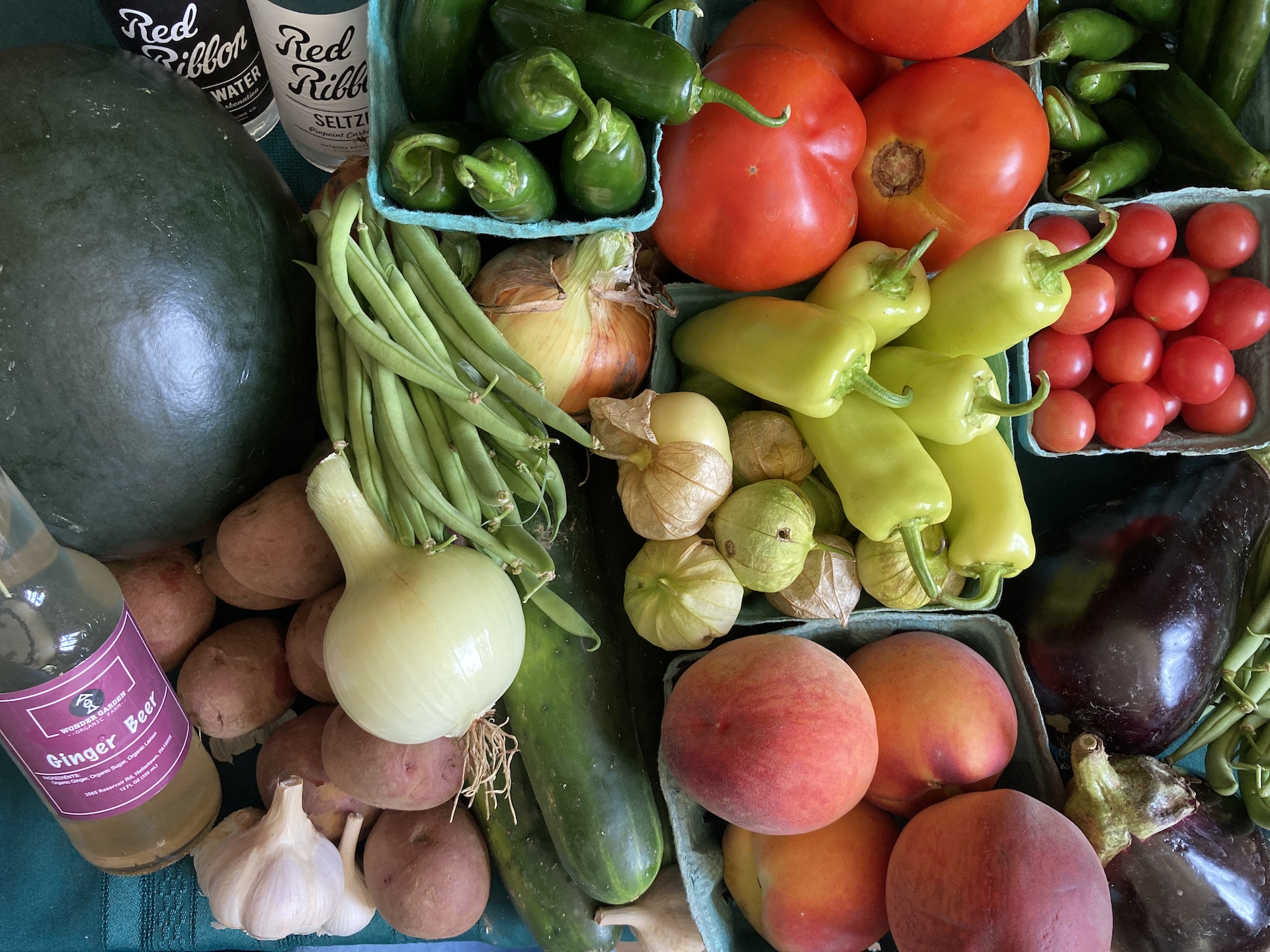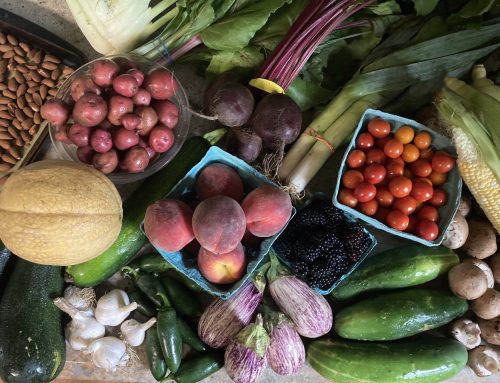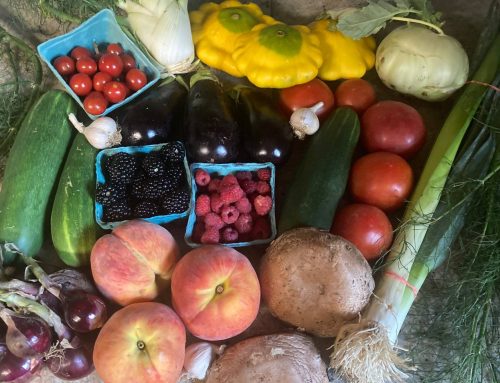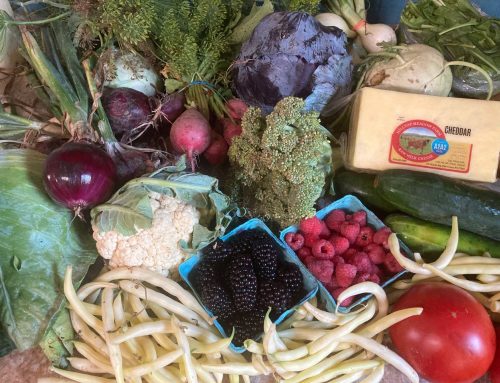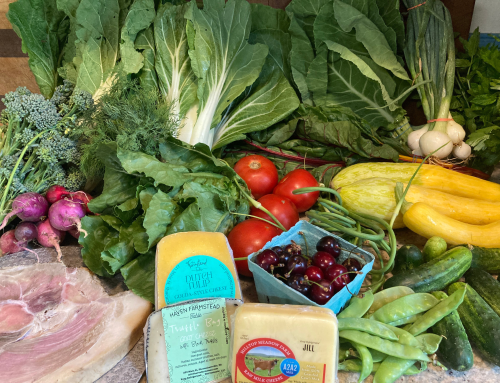Veggies We Harvested This Week: Aug 1, 2023
Every member’s customized Market Box is unique so we hope you will take advantage more varieties of vegetables as you get comfortable with all the great organic produce we are offering. Use our A to Z Vegetable Guide to help use and store your veggies. Storage tips and recipes below.
Storage & Usage Tips
I explain hot peppers and tomatillos. PLUS lots of creative drink options with your fruit.
All this and more in my unboxing video:
What to use first: eggplant, basil, lettuce, microgreens, red raspberries, blackberries, eggplant
Finished for the season: Asparagus, garlic scapes, snap peas, chamomile, rhubarb, scallions,
Done for now but will return: Broccoli, Bok choy, Radish, Napa Cabbage, Collards, Kale,
Basil – store as with all herbs. Basil doesn’t like being in a bag in the fridge for very long. A fragrant basil with reminiscent of cinnamon, purple Basil can be used any way Italian basil can – even Pesto. Purple Pesto will be unique in color but finds it’s place in pasta quite easily. Store as with all herbs. Basil doesn’t like being in a bag in the fridge for very long. Green Basil is the classic italian basil for Pesto Recipes. Trim stems and place basil upright in a glass of water in the fridge or on your kitchen counter. Basil pairs well with summer squash, cucumbers, tomatoes and many others. If you cannot use the basil this week, preserve the herb by tying a string around the bunch and hanging it upside down in a well-ventilated and dry area. When it’s dry, crumble and store in an airtight container. One of my favorite salads with Basil, Cucumber and Lettuce
Beets, red – If greens are attached to the beets, cut the stems two inches about the beet root bulb. Store greens separately. Use beet greens first, within one or two days. I love beets. My favorite summer salad is with beets, walnuts and parmesan. Some people love beets. Others will try to hide them in other things. Try Beet Chips – even for those who don’t like beets. Or hide them in baked treats: 11 Beet Recipes that Don’t Taste Like Dirt. This Ukrainian Salad uses many of the vegetables in your box this week.
Cabbage – General instructions for all types: To store: Place dry, unwashed cabbage heads in the refrigerator, preferably in the vegetable bin. To prep: Rinse the cabbage under cold water before use. Cut cabbage head in half. Be sure to remove the stem end and triangular core near the base. To use: Eat raw in salads, steamed, braised or fried. Turn raw cabbage into coleslaw or sauerkraut. Roast cabbage steaks/slices at 400 F drizzled with olive oil and salt. Or try stir-frying shredded cabbage in olive oil until wilted with a little bit of minced garlic. To freeze: Choose how to cut your heads based on your end use. Cook in boiling pot of water for 90 seconds. Douse in ice water to stop the cooking process. Drain the cabbage and dry as much as possible. Place in Ziplock freezer bags based on your portions you plan to use, and remove as much air as possible. Put in freezer.
Cabbage, green – this is a green summer cabbage, which means that it is great for any cabbage recipe but it is not meant for long term storage like fall cabbages. It is slaw season so here is another recipe, with a twist: Lime Ginger Slaw.
Cabbage, red – Make a very pretty Red Cabbage Slaw. Braised Red Cabbage or this version with apples and onions for a cooked side dish. Freeze this Amish Freezer Slaw and use your Red Cabbage instead of Green.
Caraflex Cabbage – also known as conehead cabbage or pointy cabbage, is a type of cabbage that has a unique, conical shape with tightly packed leaves. It is a member of the Brassica family and has a mild and slightly sweet flavor. Caraflex cabbage is a nutritious vegetable that is low in calories and high in vitamins A and C, dietary fiber, and antioxidants. It also provides minerals such as potassium and calcium. Storage: To store caraflex cabbage, keep it unwashed and dry. Place it in a perforated plastic bag or wrap it loosely in a plastic wrap to maintain its moisture. Store it in the refrigerator’s crisper drawer, where it can last for up to a week. Avoid storing caraflex cabbage near fruits or vegetables that produce ethylene gas, as this can cause it to spoil faster. Usage: Try raw in salads, slaws, or used as a crunchy addition to sandwiches or tacos. Caraflex cabbage can also be cooked by stir-frying, sautéing, roasting, or steaming. Its tender yet crisp texture makes it suitable for stir-fries, soups, stir-fried noodles, and other cooked dishes.
Special Usage: Due to its cone-like shape, caraflex cabbage is great for stuffing. The individual leaves can be filled with a variety of ingredients, such as grains, proteins, or vegetable mixtures, and then baked or steamed. The leaves can also be used as wraps for healthier and low-carb alternatives to traditional wraps or tortillas.
Cucumber, Pickling – store in a loosely sealed plastic bag in the fridge. This is your opportunity to make a Refrigerator pickle (also called a Quick Pickle) or a Fermented Pickle. Both are easy, though fermented pickles have more probiotic advantages. This blog post will help as well: Ten Strategies For Dealing With An Abundance Of Cucumbers. You may still use pickling cucumbers as snacks or in salads. They just work better for pickling than an english or slicing cucumber.
Cucumber, Slicing – store in a loosely sealed plastic bag in the fridge. Cucumber Salad is a classic!
Eggplant can be left unrefrigerated at a cool room temperature for a day or two or in the crisper drawer for one week but it tastes best when used soon after picking. Eggplant can be peeled or unpeeled depending on the type of dish you are preparing.Just like a zucchini doesn’t have much flavor on its own so it’s often paired with other veggies in a dish, so, too, the eggplant is often paired with other stronger flavors. It can be sauteed, baked, fried, grilled, or steamed. You can freeze eggplant when it is cooked in a dish like ratatouille or baba ghanouj, and enjoy the classic eggplant parmesan or pick from these 8 simple ways to cook eggplant.
Salting & Draining Eggplant – It’s a good idea, if time allows, to salt the sliced or chopped eggplant and soak in water for about 15 minutes and then gently drain and squeeze to get rid of acrid flavors according to From Asparagus to Zucchini cookbook.
Eggplant, Japanese – slender varieties of many color variations of purple and white, see pictures above. Lends well to sliced circles.
Eggplant, Purple – italian globe variety lends itself to stuffing, slicing, cubing and roasting. You can freeze eggplant when it is cooked in a dish like ratatouille or baba ghanouj, and enjoy the classic eggplant parmesan or pick from these 8 simple ways to cook eggplant.
Kohlrabi – green or purple variety. Cut off leaves and store separately in a plastic bag – you can use them like kale! Most likely you will receive purple kohlrabi which is more often used as a cooked vegetable. Green varieties are very suitable raw and may be cooked as well. Store bulbs in a bag or wrap in a moist paper towel. Both parts should be stored in the vegetable drawer of the refrigerator. This post has great info and suggestions for Kohlrabi. Other CSA members have enjoyed their kohlrabi grilled, roasted and spiralized into noodles.
Lettuce, Romaine – Store your lettuce properly and enjoy summer salads with sliced vegetables from your box. Lettuce Soup is always an option if you don’t feel like having another salad. This could be frozen as well and substitute a bit of onion for leek.
Microgreens – Refrigerate immediately. Keep bag sealed. Fold down to remove most air. Put in coldest part of refrigerator. Often, a bottom shelf. Can be frozen to add later to soups and other meals. Check out Emanuel Farm Powdered Microgreens for longer term shelf life. They are a tasty, nutrient-rich boost for shakes, smoothies and meals and a great seasoning for adding flavor to dishes and dips. All our micro greens are from Emanuel Farms.
Onion, candy – are fresh onions, not for long term storage, which often have the greens still attached. If included, leaves are edible, just like scallions. Candy onions are yellow but are sweeter, milder, fresh onion to be used in salads, sandwiches but not for long term storage.
Peppers – are a popular and versatile vegetable that comes in various colors, including green, red, yellow, orange, and even purple. They belong to the nightshade family and have a mildly sweet flavor with a crisp texture. Peppers are low in calories and fat but rich in vitamins and minerals. They are particularly high in vitamin C, providing more than 100% of the recommended daily intake per serving. Peppers also contain vitamin A, vitamin B6, dietary fiber, and antioxidants, such as carotenoids and flavonoids, which contribute to their vibrant colors and potential health benefits.
Storage for all peppers: keep them dry and refrigerated in a perforated plastic bag for up to one to two weeks. Avoid storing them with fruits or vegetables that emit ethylene gas, as this can cause them to spoil faster.
Usage: Peppers can be used raw in salads or as a crunchy snack, and they are excellent for stir-fries, sautés, soups, stuffed dishes, or grilled kebabs, adding flavor and nutrition to various meals. Their different colors can also add an appealing visual touch to your dishes.
Garlic – should be kept in a cool, dry place. All our garlic is now cured so it can be stored in a cool, dark, dry place for several months. Use in any recipe and add peeled cloves to pickles.
Green Beans – Beans should be stored in a loosely sealed plastic bag for about a week in the crisper drawer. I like this unique way of cooking green beans: Blistered green beans with garlic. Green Bean Salad with Red Onion and Tomato Recipe. This recipes uses a variety of summer veggies: Summer Vegetable Stew – Zucchini, Squash, Beans, Tomato, Eggplant. See this post for Freezing Fresh Beans.
Green Bell Peppers– Green peppers pack the most nutritious punch when eaten raw. Try on salads, sandwiches, or dipped into a favorite dip. Cooked, green pepper can be used in soups, chili, casseroles, egg dishes, or stir-fries. Can be sliced, diced and frozen for later cooked dishes. Black Bean & Corn Salad, Stuffed Tomatoes or Peppers.
Hungarian Wax – also known as hot wax peppers or hot banana peppers, are elongated chili peppers originating from Hungary. They have a mildly spicy flavor, ranging from mild to moderately hot, and are commonly used in cooking and pickling due to their versatility and unique taste. Nutritionally, Hungarian wax peppers have the added health benefits from the compound capsaicin.
Usage: Hungarian wax peppers can be used raw in salads, sandwiches, or as a zesty garnish for tacos and burgers. For cooking, try sautéing, grilling, roasting, or stuffing them with fillings like cheese, rice, or seasoned meats. Incorporate these peppers into sauces, soups, stews, or stir-fries for added depth and heat to your dishes.Consider pickling any excess peppers for prolonged enjoyment of their tangy flavor.
Heat Index: The heat level of Hungarian wax peppers can vary from mild to moderately hot, depending on their ripeness and individual variation. Pale yellow peppers tend to be milder, while fully ripe red peppers may have more significant heat. Taste a small piece before use to gauge spiciness and adjust according to your preference.
Jalapeño – a popular variety of chili peppers with a distinctive bright green or red color when fully ripe. They are low in calories and fat while providing a good amount of vitamins A and C, as well as potassium and dietary fiber. They also contain capsaicin, the compound responsible for their spiciness, which is known for its potential health benefits, such as pain relief and metabolism-boosting properties.
Usage: Jalapeño peppers are commonly used raw in salsas, guacamole, and as a topping for tacos, nachos, pizza and other dishes. When cooked, jalapeños add a bold kick to soups, stews, sauces, and stir-fries. They can also be roasted, stuffed, or incorporated into marinades for meats and vegetables, offering a depth of flavor and heat.
Heat Index: Jalapeño peppers are known for their moderate to high heat level, typically ranging from 2,500 to 8,000 Scoville Heat Units (SHU). The level of spiciness can vary depending on factors such as ripeness and the specific pepper’s genetics. IMPORTANT: USE GLOVES! Be cautious when handling jalapeños (at least if you are handling more than a few at a time or are sensitive), as their seeds and membranes contain the most capsaicin and can intensify the heat. Remove these parts if you prefer a milder flavor or keep them for a spicier kick.
Serrano – are hot chili peppers widely used in Mexican and Latin American cuisines. They are smaller and narrower than jalapeño peppers, with a bright green or red color when fully ripe.
Usage: Serrano peppers are a staple in many spicy dishes. They can be used raw in salsas, guacamole, or as a garnish for tacos, enchiladas, and other Mexican dishes, adding a bold kick to the flavors. When cooked, serrano peppers infuse stews, sauces, soups, and stir-fries with their fiery heat and rich flavor. They can be roasted, grilled, or charred to enhance their taste and used in marinades for meats and vegetables.
Heat Index: Serrano peppers have a Scoville Heat Unit (SHU) ranging from 10,000 to 23,000, making them hotter than jalapeños but milder than some other chili peppers like habaneros or ghost peppers. USE CAUTION! USE GLOVES! Many an american cook has thought, “these don’t bother my skin”, until they can’t sleep at night because of the burning sensation.
Potato, Red skinned – a type of potato of boiling potato with a bright red or pink skin and a creamy, white flesh. They have a subtly sweet and buttery flavor and are known for their smooth texture, making them versatile for various culinary uses. Nutritionally, red-skinned potatoes are a good source of vitamins and minerals, including vitamin C, potassium, and dietary fiber. They also provide antioxidants, such as anthocyanins, which contribute to their vibrant color and potential health benefits.
Storage: To store red-skinned potatoes, keep them in a cool, dark place with good ventilation, such as a pantry or cellar. Avoid storing them in the refrigerator, as the cold temperature can cause the starches to convert to sugar and affect their taste and texture. Properly stored, red-skinned potatoes can last for several weeks.
Usage: Red-skinned potatoes have a waxy texture, which means they hold their shape well when cooked. An excellent choice for boiling, steaming, and using in salads, stews, gratins and soups. Because they maintain their firmness and shape, they don’t become overly mushy after cooking. Their thin skin adds a delightful color contrast and texture to dishes, making them a popular choice for potato salads. Their slightly sweet flavor pairs well with herbs and spices, making them a delightful addition to a range of recipes.
Summer Squash – green summer squash is often called zucchini but there are many varieties of various green and yellow that are interchangeable in recipes. Try cutting in cubes, wedges, matchsticks, round or long thin slices, spiralized, and shredded for many different preparations. Try using in an herbed frittata. This delicious recipe also uses your onions Grilled Summer Squash with Feta and Onion. Check out my blog post for 10 Exit Strategies for Summer Squash Overload.
Summer Squash, Patty Pan – A special CSA variety of summer squash, that will be familiar to previous members, called “Patty Pan.” This is a great one to stuff: Stuffed Zucchini or 20 more ideas for stuffed options, or Sweet & Spicy Grilled Summer Squash.
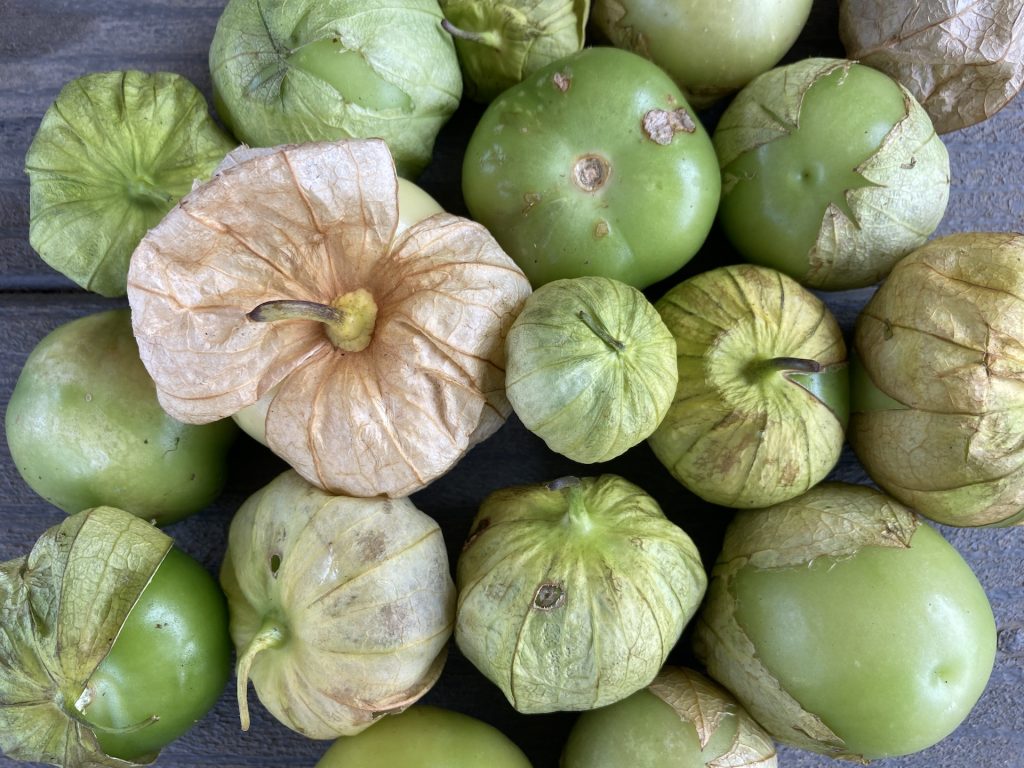
Tomatillo – Tomatillos, related to tomatoes, are also called “tomate verde” in Mexico (which means green tomato) and are
considered a staple in Mexican cooking. They are covered by a papery husk which may range from the pale green
color of the fruit itself to a light grocery-bag brown. Their texture is firm when raw with a
sweet citrus-like flavor, but soft when cooked. To Store: Store at room temperature or in the fridge with husks on, for 2-4 weeks. They should never be stored in air-tight containers. They will keep well for several weeks to a month. They may
also be frozen whole or sliced.
Tomato, Red – Keep tomatoes on the counter at room temperature. Tomatoes should not be refrigerated. Enjoy fresh in salads.
Tomato, Medium – This size of tomato is about the size of a golf ball. Use like a large cherry tomato.
Tomato, Cherry – Store on the counter; do not refrigerate. Snack or use in salad, frittata or pizza.
Farm Food Highlights
FRUIT: Yellow Watermelon – Watermelons store best out of the refrigerator for up to a few days, and you can chill them right before you want to eat them. Prolonged exposure to cold temperatures will cause the flesh to become mushy, but once you cut into the melon, it must be refrigerated immediately. Cut melon will only last a day or two in the fridge. If you don’t want to eat all your watermelon fresh off the rind, try this Watermelon, Tomato with Feta Salad.
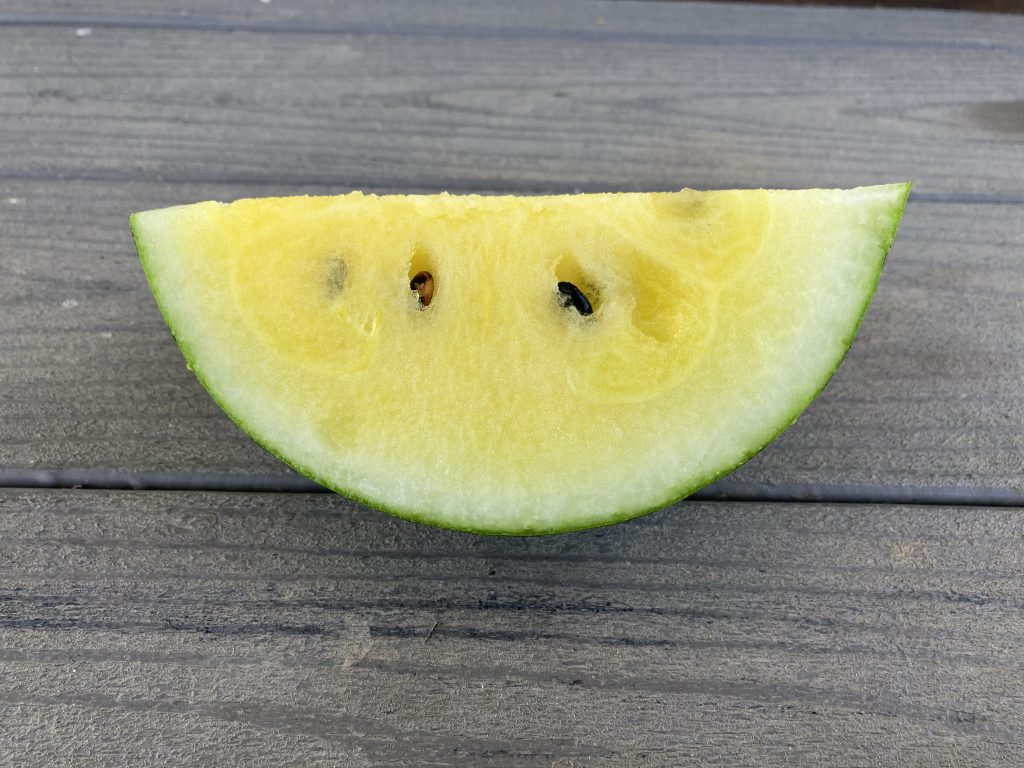
Yellow Peaches – a variety of peaches with a golden-yellow skin and a juicy, sweet flavor. They belong to the Rosaceae family and are closely related to nectarines. Yellow peaches are a good source of potassium, vitamin A and C, dietary fiber, and antioxidants like beta-carotene.
Storage: To store yellow peaches, keep them at room temperature until they reach the desired ripeness. Once ripe, you can store them in the refrigerator to slow down the ripening process and prolong their freshness. Place them in a plastic bag or container in the crisper drawer. Properly stored, yellow peaches can last for up to five days. See post: How Long to Fresh Peaches Keep?
Usage: delicious when eaten fresh as a healthy snack, added to fruit salads, or used in desserts like pies, cobblers, or fruit tarts. Their sweet and delicate flavor makes them ideal for eating as-is or incorporating into smoothies, yogurt bowls, or fruit-based sauces. Yellow peaches can also be grilled or roasted to enhance their natural sweetness and served as a dessert or alongside savory dishes like salads or grilled meats.
Blueberries – are low-calorie berries packed with vitamins, minerals, and antioxidants, including vitamin C, vitamin K, and anthocyanins. They offer immune support, contribute to bone health, and provide antioxidant protection. Storage: Keep blueberries unwashed in a covered container or loosely closed plastic bag in the refrigerator. Avoid washing them until just before use to prevent moisture. Fresh blueberries can last up to a week when properly stored. Usage: Enjoy blueberries fresh as a snack or add them to cereals, yogurt, smoothies, salads, and desserts. They can be used in baking or incorporated into savory dishes. Frozen blueberries are a convenient option for year-round use.
Blackberries – a special treat that you’ll probably want to eat these fresh and natural – they are so good! Also use to top yogurt, frosted cakes, cheesecakes, anything chocolate, etc.
This Vinegar Rinse is highly recommended for Blackberries & Raspberries: mix one part vinegar with three parts water, then gently rinse the berries in the solution. Rinse them again with plain water and pat them dry before consuming or storing.
Farm Inspired Cocktail & Mocktails:
Cocktail 1: Ginger Berry Smash A delightful cocktail that combines the fruity sweetness of blackberries with the refreshing kick of ginger beer and the smoothness of white rum. The muddled basil and maple syrup add a herbal twist to this smashing concoction.
Cocktail 2: Earl Grey Gin Fizz An elegant cocktail featuring the subtle floral notes of Earl Grey-infused American gin, paired with the effervescence of Red Ribbon Seltzer. The purple basil garnish adds a touch of sophistication to this fizzy delight.
Cocktail 3: Watermelon Jalapeno Cooler This unique cocktail packs a punch with the fusion of yellow watermelon and spicy jalapeno, perfectly balanced by the tangy and effervescent Naked Hippie Kombucha. A splash of Red Ribbon Mint Ginger Ale cools things down, creating a refreshing and revitalizing cooler.
Cocktail 4: Blam-o Mule An explosive twist on the classic Moscow Mule, this cocktail features the bold and robust flavors of HARD 21+ Blam-o Kombucha, paired with the zesty warmth of ginger beer. The green basil garnish adds a fresh touch to this exciting mule.
Mocktail 1: Peach Basil Fizz A non-alcoholic fizz that combines the sweetness of non-organic peaches with the aromatic essence of purple basil. The fizziness of Red Ribbon Seltzer makes this mocktail a sparkling and invigorating choice.
Mocktail 2: Blueberry Cucumber Spritz A refreshing mocktail that features the juicy sweetness of blueberries and the crispness of cucumber. The Bluegrass Kombucha adds complexity to the drink, making it a light and revitalizing spritz.
Mocktail 3: Watermelon Refresher A vibrant mocktail bursting with the flavors of yellow watermelon and green basil, enhanced by the delightful bitterness of Red Ribbon Tonic. This concoction is a true refresher that satisfies the taste buds.
Mocktail 4: Ginger Berry Lemonade A zesty mocktail with the richness of muddled blackberries and the tanginess of lemon juice, balanced by the sweetness of maple syrup. The ginger beer adds a sparkling and spicy element to this invigorating lemonade.
Enjoy these flavorful and creative concoctions, whether you prefer a spirited cocktail or a refreshing mocktail!
Download and Enjoy these delicious recipes!
Our members are cooking…
Farm members are sharing recipes and photos of their delicious meals on our Member Only Chat Group. Use the link in the email you received from me today.
Did you see the 2 minute tutorials for making small batch sauerkraut in the Farm Member Chat Group? Check it out if you have cabbage and want the pro-biotic boost of fermented organic veggies.
Veggie E-Books
Download these collections of tips and recipes for each veggie. You’ll use these as a reference throughout the season.
Bell Pepper E-Book
Hot Pepper Heat Guide
Fresh Salsa Formula
Onion E-Book
Tomatoes E -Book
Don’t Miss Your Farm Events:
NEW! Date Night Flower Tour
Friday, August 18
- Pick and Design your own Flower Bouquet
- Macungie Mountain Farm Lemonade & Food Truck
- herbal infusions and unique farm to table fare
- Personalized Flower Tour with Farmer Annika
- Enjoy the Farm Overlook Deck at Willow Haven Farm
- Wander the Farm and Begin to Relax from your week
- More Info Here and Share with Friends on Facebook
Last Chance!!!!!!!!!
BRICK OVEN PIZZA NIGHT
Saturday, Aug 5, 2023. 5 pm – 8 pm.
More details and reservations.
Share this Event on Facebook for us! And see what disparaging remarks Patricia Green posts for all to see.
Harvest of Wisdom Homesteading Conference at Willow Haven Farm
Saturday, September 2. 8 am – 3 pm.
- morning and afternoon workshops with breakfast and lunch
- hands on workshops
- sourdough bread baking – limit 12 participants
- home cheese making – limit 12 participants
- chicken butchering
- food preservation – perhaps curing meat
- foraging herbs walk with “make and take”
- in depth farm tours with Farmer Reuben
- organic systems for vegetable growing
- organic systems for pastured dairy animals
Limited space. Must register for high demand workshops.
Market Box Value!
Five of our Top Tips to get the most value out of your Market Box and enjoy the most food you’ll love. Read Here.
Your List of What to Return:
Please return the packaging we sent you for your last delivery. Here’s how and what exactly we’ll take back: Read Here.
We’ll Keep Farming for You!

